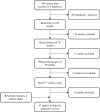Ultraviolet sensitivity of WASH (water, sanitation, and hygiene) -related helminths: A systematic review
- PMID: 31536504
- PMCID: PMC6772140
- DOI: 10.1371/journal.pntd.0007777
Ultraviolet sensitivity of WASH (water, sanitation, and hygiene) -related helminths: A systematic review
Abstract
Background: Helminthiases are a group of disabling neglected tropical diseases that affect billions of people worldwide. Current control methods use preventative chemotherapy but reinfection is common and an inter-sectoral approach is required if elimination is to be achieved. Household and community scale water treatment can be used to provide a safe alternative water supply for contact activities, reducing exposure to WASH (water, sanitation, and hygiene) -related helminths. With the introduction of ultraviolet light emitting diodes (UV-C LEDs), ultraviolet (UV) disinfection could be a realistic option for water treatment in low-income regions in the near future, to provide safe alternative water supplies for drinking and contact activities such as handwashing, bathing, and laundry, but currently there is no guidance for the use of UV or solar disinfection against helminths.
Methodology: A qualitative systematic review of existing literature was carried out to establish which WASH-related helminths are more susceptible to UV disinfection and identify gaps in research to inform future studies. The search included all species that can infect humans and can be transmitted through water or wastewater. Five online databases were searched and results were categorized based on the UV source: sunlight and solar simulators, UV-A and UV-B (long wavelength) sources, and UV-C (germicidal) sources.
Conclusions: There has been very little research into the UV sensitivity of helminths; only 47 studies were included in this review and the majority were carried out before the standard protocol for UV disinfection experiments was published. Only 18 species were studied; however all species could be inactivated by UV light. Fluences required to achieve a 1-log inactivation ranged from 5 mJ/cm2 to over 800 mJ/cm2. Larval forms were generally more sensitive to UV light than species which remain as an egg in the environment. This review confirms that further research is required to produce detailed recommendations for household or community scale UV-C LED or solar disinfection (SODIS) of water for preventing helminthiases.
Conflict of interest statement
The authors have declared that no competing interests exist.
Similar articles
-
Ultraviolet disinfection of Schistosoma mansoni cercariae in water.PLoS Negl Trop Dis. 2021 Jul 6;15(7):e0009572. doi: 10.1371/journal.pntd.0009572. eCollection 2021 Jul. PLoS Negl Trop Dis. 2021. PMID: 34228750 Free PMC article.
-
Evaluation survey of microbial disinfection methods in UV-LED water treatment systems.Sci Total Environ. 2019 Apr 1;659:1415-1427. doi: 10.1016/j.scitotenv.2018.12.344. Epub 2018 Dec 24. Sci Total Environ. 2019. PMID: 31096352 Review.
-
Application of ultraviolet light-emitting diodes (UV-LEDs) for water disinfection: A review.Water Res. 2016 May 1;94:341-349. doi: 10.1016/j.watres.2016.03.003. Epub 2016 Mar 2. Water Res. 2016. PMID: 26971809 Review.
-
School Water, Sanitation, and Hygiene, Soil-Transmitted Helminths, and Schistosomes: National Mapping in Ethiopia.PLoS Negl Trop Dis. 2016 Mar 8;10(3):e0004515. doi: 10.1371/journal.pntd.0004515. eCollection 2016 Mar. PLoS Negl Trop Dis. 2016. PMID: 26954688 Free PMC article.
-
Application of GaN-based ultraviolet-C light emitting diodes--UV LEDs--for water disinfection.Water Res. 2011 Jan;45(3):1481-9. doi: 10.1016/j.watres.2010.11.015. Epub 2010 Nov 16. Water Res. 2011. PMID: 21115187
Cited by
-
The lethal effect of soap on Schistosoma mansoni cercariae in water.PLoS Negl Trop Dis. 2024 Jul 29;18(7):e0012372. doi: 10.1371/journal.pntd.0012372. eCollection 2024 Jul. PLoS Negl Trop Dis. 2024. PMID: 39074137 Free PMC article.
-
Photochemical advanced oxidative process treatment effect on the pesticide residues reduction and quality changes in dried red peppers.Sci Rep. 2023 Mar 17;13(1):4444. doi: 10.1038/s41598-023-31650-4. Sci Rep. 2023. PMID: 36932134 Free PMC article.
-
Approaches to safe water, environmental sanitation, and hygiene in the Democratic Republic of Congo - editorial.Ann Med Surg (Lond). 2023 Jul 3;85(8):3772-3773. doi: 10.1097/MS9.0000000000000342. eCollection 2023 Aug. Ann Med Surg (Lond). 2023. PMID: 37554907 Free PMC article. No abstract available.
-
Ultraviolet disinfection of Schistosoma mansoni cercariae in water.PLoS Negl Trop Dis. 2021 Jul 6;15(7):e0009572. doi: 10.1371/journal.pntd.0009572. eCollection 2021 Jul. PLoS Negl Trop Dis. 2021. PMID: 34228750 Free PMC article.
References
-
- World Health Organization. Global Health Estimates 2016: Disease burden by Cause, Age, Sex, by Country and by Region, 2000–2016. Geneva, Switzerland: World Health Organization; 2018.
-
- World Health Organization. Preventive chemotherapy in human helminthiasis. Coordinated use of anthelminthic drugs in control interventions: a manual for health professionals and programme managers. Geneva, Swizterland: World Health Organization; 2006.
-
- World Health Organization. Integrating neglected tropical diseases into global health and development: fourth WHO report on neglected tropical diseases. Geneva, Switzerland: World Health Organization; 2017.
-
- Freeman MC, Ogden S, Jacobson J, Abbott D, Addiss DG, Amnie AG, et al. Integration of Water, Sanitation, and Hygiene for the Prevention and Control of Neglected Tropical Diseases: A Rationale for Inter-Sectoral Collaboration. PLOS Neglected Tropical Diseases. 2013;7(9):e2439 10.1371/journal.pntd.0002439 - DOI - PMC - PubMed
Publication types
MeSH terms
Substances
Grants and funding
LinkOut - more resources
Full Text Sources
Medical


